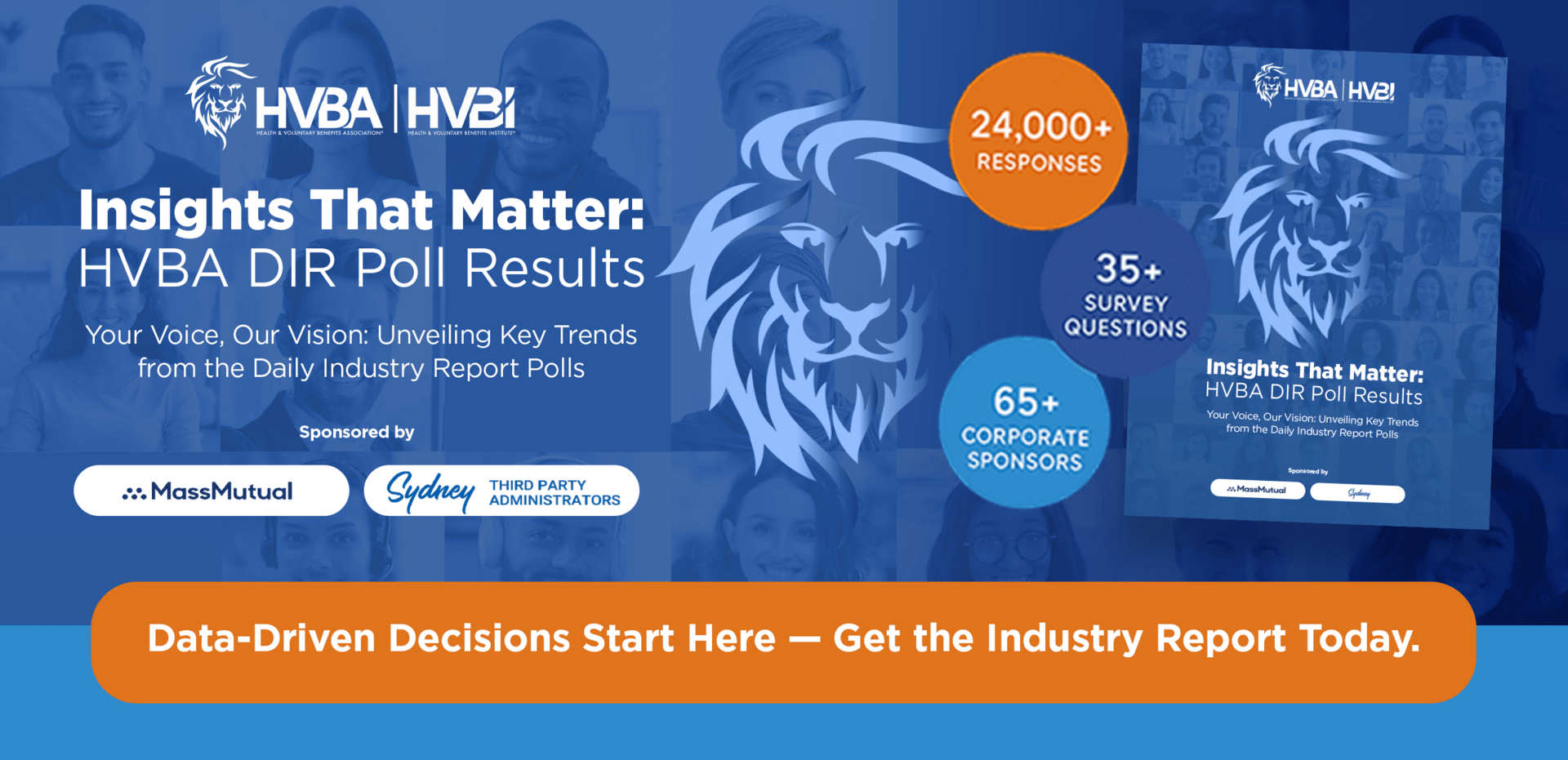- Daily Industry Report
- Posts
- Daily Industry Report - July 29
Daily Industry Report - July 29

Your summary of the Voluntary and Healthcare Industry’s most relevant and breaking news; brought to you by the Health & Voluntary Benefits Association®
Jake Velie, CPT | Robert S. Shestack, CCSS, CVBS, CFF |
'Smaller margins'
By Liese Klein - You know you're in trouble when the pharmacy worker catches your eye and lowers her voice: "You know how much this costs, right?" That drug that works so well for your chronic condition is about to bust your budget - but do you really want to walk away and go back to being sick? Read Full Article…
HVBA Article Summary
Rising Prescription Drug Costs Strain Connecticut: Drug prices in the state have surged at a pace exceeding both national and regional trends, with per-person spending climbing to $1,851 in 2023. This rapid growth is placing significant financial strain on hospitals already facing labor and operational cost increases, while also driving affordability concerns for residents and employers who are struggling with higher insurance premiums and out-of-pocket expenses.
Legislative Action Targets Affordability: In response to mounting cost pressures, Connecticut lawmakers passed a bipartisan package of a dozen measures designed to address drug pricing from multiple angles. These initiatives include tighter regulation of pharmacy benefit managers, state-imposed caps on select drug prices, expansion of bulk purchasing programs, studies on importing Canadian drugs, reforms to ensure discount card savings count toward insurance deductibles, and exploration of manufacturing state-produced versions of expensive GLP-1 drugs like Ozempic and Wegovy to reduce future spending.
Balancing Affordability and Industry Impact: While hospitals, patients, and businesses broadly support efforts to curb drug prices, Connecticut’s biopharma sector warns that certain policies—particularly proposals to create state-made versions of GLP-1 drugs—could undermine pharmaceutical innovation and threaten thousands of high-paying jobs. Policymakers, industry leaders, and patient advocates emphasize the need for collaborative solutions and greater transparency to ensure cost-control efforts do not unintentionally destabilize the healthcare ecosystem or local economy.
HVBA Poll Question - Please share your insightsShould A&H carriers provide a 1099 for Accident, Critical Illness, and Hospital Indemnity claims exceeding $600? |
Our last poll results are in!
59.38%
Of Daily Industry Report readers who participated in our last polling question, when asked, “What strategies do you feel are most effective to gain deeper transparency into — and thereby better manage — total pharmacy spend?” responded with “disaggregate PBM management & functions (formularies, clinical, claims, network access & rebates).”
25% feel the most effective strategies are to “leverage robust data & reporting tools that allow you to analyze costs and trends,” while 9.37% believe it to be “partnering with a smaller, more flexible PBM that will allow formulary customization.” The remaining 6.25% feel that “carve-out specialty vs. traditional drugs, especially the biosimilar drugs,” are the most effective strategies to gain deeper transparency into — and therefore better manage — total pharmacy spend.
Have a poll question you’d like to suggest? Let us know!
Employee leasing firm sees health costs climbing 9% after benefits cuts
By Allison Bell - Health benefits cost increases are pounding a company that rents workers to other companies. Mike Simonds, the chief executive officer of TriNet, a professional employer organization, said Friday that average health benefits costs are up about 9% this year, even after employers reduce the richness of their health benefits, increasing the enrollees' out-of-pocket costs and take other steps to hold down increases. Read Full Article… (Subscription required)
HVBA Article Summary
Rising Health Costs Impact Growth: TriNet is navigating substantial increases in healthcare expenses by raising the health plan fees it charges to client employers. While this strategy helps offset rising costs and stabilize its operations, it has led to slower sales growth compared to last year as employers react cautiously in a challenging economic environment where affordability remains a key concern.
Targeted Growth Despite Challenges: Despite the slowdown tied to fee increases, TriNet continues to acquire higher-quality employer accounts in the industries it wants to target. The company emphasizes that its pricing strategy remains competitive with other professional employer organizations (PEOs), positioning it to stay aligned with market expectations as it prepares for the upcoming selling season.
Earnings Reflect Industry Pressures: In its second-quarter results, TriNet reported $37 million in net income on $1.2 billion in revenue, down from $60 million on the same revenue a year earlier. The decline highlights how rising health benefit costs are straining profitability, a challenge that reflects broader trends across employer-sponsored health plans as costs are projected to continue climbing into 2026.
Medicare Advantage in 2025: Enrollment Update and Key Trends
By Nancy Ochieng, Meredith Freed, Jeannie Fuglesten Biniek, Anthony Damico, and Tricia Neuman - Enrollment in Medicare Advantage, the private plan alternative to traditional Medicare, has increased steadily over the past two decades, with more than half of eligible beneficiaries enrolled in Medicare Advantage since 2023. The growth in enrollment has implications for federal spending, because according to the Medicare Payment Advisory Commission (MedPAC), Medicare payments to private plans are higher than spending for similar beneficiaries in traditional Medicare. Read Full Article…
HVBA Article Summary
Rising Federal Spending Spurs Policy Debate: Payments per Medicare Advantage enrollee are 20% higher in 2025, contributing to an additional $84 billion in federal spending this year, compared to $18 billion a decade ago when far fewer beneficiaries were enrolled. Policymakers are increasingly scrutinizing how Medicare pays private plans, facing challenges in balancing cost containment with preserving beneficiary access to plan choices and supplemental benefits such as dental, vision, and hearing coverage.
Special Needs Plans Drive Enrollment Growth: More than half (54%) of eligible Medicare beneficiaries—34.1 million people—are enrolled in Medicare Advantage in 2025, though overall growth slowed to 4% compared to 7% the prior year. Special Needs Plans (SNPs) accounted for 48% of the total year-over-year enrollment increase, with chronic condition SNPs (C-SNPs) driving the surge by growing more than 70% compared to modest gains in dual-eligible SNPs (D-SNPs) and flat growth in institutional SNPs.
Market Dominance by Major Insurers Continues: Enrollment in Medicare Advantage remains concentrated among a small group of insurers, with UnitedHealth Group and Humana together covering 46% of all enrollees nationwide in 2025. UnitedHealth experienced the largest enrollment growth with 505,000 new members, Elevance Health gained 249,000, while Humana’s enrollment fell by roughly 297,000, underscoring the shifting dynamics among leading parent organizations despite their continued market dominance.
10 states with the best, worst healthcare
By Mariah Taylor - New Hampshire has the best healthcare at the most reasonable cost in the nation, according to a ranking by WalletHub published July 28. To determine the states where Americans receive the best or worst healthcare, the personal finance website compared all 50 states and the District of Columbia across 44 measures linked to cost, accessibility and outcome. Read Full Article…
HVBA Article Summary
Healthcare Quality and Affordability Scores Vary Widely: WalletHub evaluated each U.S. state’s healthcare system using a broad set of metrics, including the cost of medical visits, average hospital expenses per inpatient, hospital bed availability, emergency department wait times, various mortality rates, and patient readmission rates. Each state was scored on a 100-point scale, where higher scores reflected better healthcare access and outcomes at more reasonable costs, revealing substantial variation across the country.
Data-Driven Rankings Reflect Weighted Metrics: To determine each state’s overall score, WalletHub applied a weighted average across all metrics, giving different importance to factors like cost, access, and outcomes. The rankings were built using data collected as of June 30 from reputable sources including the CDC, CMS, and the U.S. Census Bureau, ensuring the findings reflected recent, nationally recognized statistics.
Top and Bottom States Highlight Disparities: The analysis found New Hampshire, Rhode Island, and Minnesota at the top, scoring highest for delivering quality care at more affordable prices, while Mississippi, Alaska, and Alabama ranked at the bottom. These rankings highlight the considerable differences in healthcare value across states, emphasizing ongoing disparities in cost efficiency, access, and health outcomes nationwide.
Preventative Care Programs Deliver 3.6x ROI for Employers
By FitOn Health - Chronic health conditions are a relentless financial strain on employers. Whether it’s rising healthcare costs tied to obesity, diabetes, MSK, or mental health conditions, the economic impact continues to rise year after year. But new research reveals that investing in preventive care programs for employees not only addresses these challenges, it pays off in significant ways. Read Full Article…
HVBA Article Summary
Chronic Conditions Drive Costs: With 6 in 10 U.S. adults living with at least one chronic disease — many managing multiple conditions — employers are facing mounting costs tied to obesity, diabetes, heart disease, and mental health issues. Obesity alone drives nearly $173 billion in U.S. medical expenses annually, along with $3.4 to $6.4 billion in productivity losses from absenteeism. Diabetes adds an estimated $306.6 billion in direct medical costs each year, while depression and anxiety cost the global economy more than $1 trillion annually in lost productivity, with employers absorbing a substantial share.
Preventive Care Delivers Measurable ROI: Employers that implement preventive health programs — such as coaching, exercise initiatives, and chronic care management — are seeing a 3.6x return on investment through reduced healthcare costs and improved employee productivity. On average, engaged employees contribute to $359 in annual savings each, and a company with 1,200 participants can achieve $433,228 in yearly combined healthcare and productivity savings, proving that early intervention can generate substantial cumulative financial impact.
A Strategic Imperative for Employers: To counter rising healthcare costs and strengthen workforce performance, employers should integrate preventive health as a core part of their benefits strategy. Investing in well-being initiatives — from mental health support and fitness programs to chronic care management — not only reduces expenses but also boosts employee satisfaction, retention, and organizational resilience, positioning businesses for long-term success.
Providers continue antitrust opposition against Blue Cross Blue Shield
By Noah Tong - Nonprofit health system Texas Health Resources has sued the Blue Cross Blue Shield Association (BCBSA) and its entities for entering into agreements to limit reimbursements to providers since 2008. The plaintiffs, in the 179-page lawsuit filed this week, allege horizontal market allocation and price-fixing by geographically restricting how many Blues plans do business in each region. Read Full Article…
HVBA Article Summary
Anti-Competitive Practices and Rising Costs: Texas Health Resources claims that the Blue Cross Blue Shield Association (BCBSA) and its member plans engage in practices that limit competition by avoiding direct rivalry with one another. Through programs like BlueCard and national accounts, the Blues allegedly share profits while paying providers “artificially reduced prices,” which, according to the lawsuit, undermines providers’ bargaining power and drives up overall costs for employers seeking to cover their workforce.
Ongoing Legal Challenges and Settlements: This lawsuit builds on a history of legal actions against BCBSA, including a $2.8 billion settlement with providers over alleged collusion to suppress competition and lower reimbursement rates. While BCBSA denied wrongdoing in that case, many providers have opted out of the settlement and pursued fresh lawsuits, arguing that despite the settlement terms, the Blues have not significantly altered their business practices or the way they contract with providers.
Provider Leverage and Employer Impact: Texas Health Resources is requesting that the court block BCBSA from continuing to use programs such as BlueCard, national accounts, and inter-plan agreements. The health system argues that these mechanisms allow Blues plans to maintain a dominant market position, restrict providers’ ability to negotiate favorable terms, and ultimately increase the administrative and coverage costs that employers must absorb, especially when operating across multiple states.
Build Business Resilience With Voluntary Benefits
By Principal - In today’s unpredictable business environment, small and midsize business (SMB) owners face mounting pressures from all directions. From rising costs to ongoing workforce challenges, the need for resilience has never been greater. Read Full Article…
HVBA Article Summary
Voluntary Benefits as a Cost-Effective Strategy: Voluntary benefits—such as critical illness, accident, and hospital indemnity insurance—offer employers a way to enhance their benefits packages without adding substantial costs. These employee-paid or shared-cost options provide flexibility and customization, helping organizations appeal to diverse workforce needs while maintaining budget control.
Retention and Employee Well-Being as Priorities: Nearly 60% of businesses report difficulty finding qualified talent, and 82% acknowledge that benefits are essential to employee loyalty. By offering more comprehensive benefits, including voluntary options, employers can better support their teams, address financial stressors like inflation, and respond to rising mental health concerns, all of which can strengthen retention and workplace satisfaction.
Financial Protection and Organizational Resilience: Supplemental benefits serve as a safety net for employees during unexpected medical or financial crises, offering direct financial support when it’s needed most. These benefits not only help employees focus on recovery but also reduce costly turnover for employers, ultimately boosting organizational resilience in times of market and economic uncertainty.

Tirzepatide Tops TRT for Men With Hypogonadism and Obesity
By Miriam E. Tucker - Tirzepatide is a promising treatment for metabolic hypogonadism in men with obesity, new research suggested. In a study of 83 men with obesity, functional hypogonadism, and insulin resistance, those treated with the dual glucose-dependent insulinotropic peptide and glucagon-like peptide 1 (GLP-1) receptor agonist tirzepatide for 2 months had greater weight loss, increased endogenous testosterone production, and improved erectile dysfunction compared to those treated with transdermal testosterone replacement therapy (TRT) or who received no treatment. Read Full Article…
HVBA Article Summary
Tirzepatide Outperforms Lifestyle and Testosterone Therapy: In obese men with metabolic hypogonadism, tirzepatide produced significantly greater improvements over two months in weight loss (averaging an 8.1% reduction), body composition, and hormonal markers such as testosterone, LH, and FSH compared to lifestyle changes alone or testosterone replacement therapy. It also led to more notable gains in erectile function, suggesting benefits that extend beyond weight reduction alone.
Restoration of Natural Hormonal Function: Unlike testosterone therapy, which can suppress gonadotropin production, tirzepatide appeared to restore hypothalamic-pituitary-gonadal axis function, as reflected by increases in LH and FSH alongside testosterone. This indicates it may help address underlying metabolic drivers of hypogonadism rather than simply offering symptomatic testosterone replacement.
Potential Shift in Clinical Practice: Endocrinologists presenting at and commenting on ENDO 2025 suggested GLP-1–based therapies like tirzepatide could become preferred first-line treatments for select men with metabolic hypogonadism. By promoting both substantial weight loss and natural hormonal recovery, these therapies may reduce reliance on testosterone replacement, though more long-term research is needed to confirm their sustained efficacy and safety.







